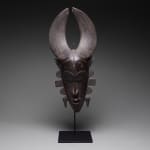Ligbi Wooden Mask, 20th Century CE
Wood
48.3 x 22.2 cm
19 x 8 3/4 in
19 x 8 3/4 in
PF.3285
Further images
This beautiful, dark wood mask captures our eyes with its simple elegance and graceful symmetry. Sculpted in a highly stylized manner, this mask displays a set of wide horns. Both...
This beautiful, dark wood mask captures our eyes with its simple elegance and graceful symmetry. Sculpted in a highly stylized manner, this mask displays a set of wide horns. Both sides of the face are decorated with semi-circular and rectangular structures. The scarification enhances its protruding mouth, and cross-hatching marks decorate parts of the mask. Such a facemask is used at the ceremony of the Lo. It stands primarily as a symbol of the metaphysical world in which the imperfection of human existence is strongly emphasized. The finely decorated and often beautifully polished masks show Ligbi artists' artistic skill and their marvelous depiction of dignified, stylized human face containing symbolic elements. The wooden mask is oval and the face stands out in sharp relief above the surface. As portrayed beautifully by this mask, the brows are arched crescents above the narrow, downcast slit eyes (characteristic of the Ligbi), and a small open mouth with teeth lies below the long thin nose. It is also furnished with antelope horns, whose magic power increases the holiness of the mask. Complementing the horns are the two appendages hanging on either side of the chin called "legs," which are dervied from Kpeliyee masks from the neighboring Senufo tribe whose art highly influenced the Ligbi. The rectangular or semi-circular flat pieces on sides of the mask are meant to represent a greatly stylized coiffure. African art, such as this Ligbi mask, thus, was not only rich in the visual aspect but also in cultural and historical aspects. Its reference to religious and spiritual world brings the modern viewers past the already ancient time of the mask's creation.







